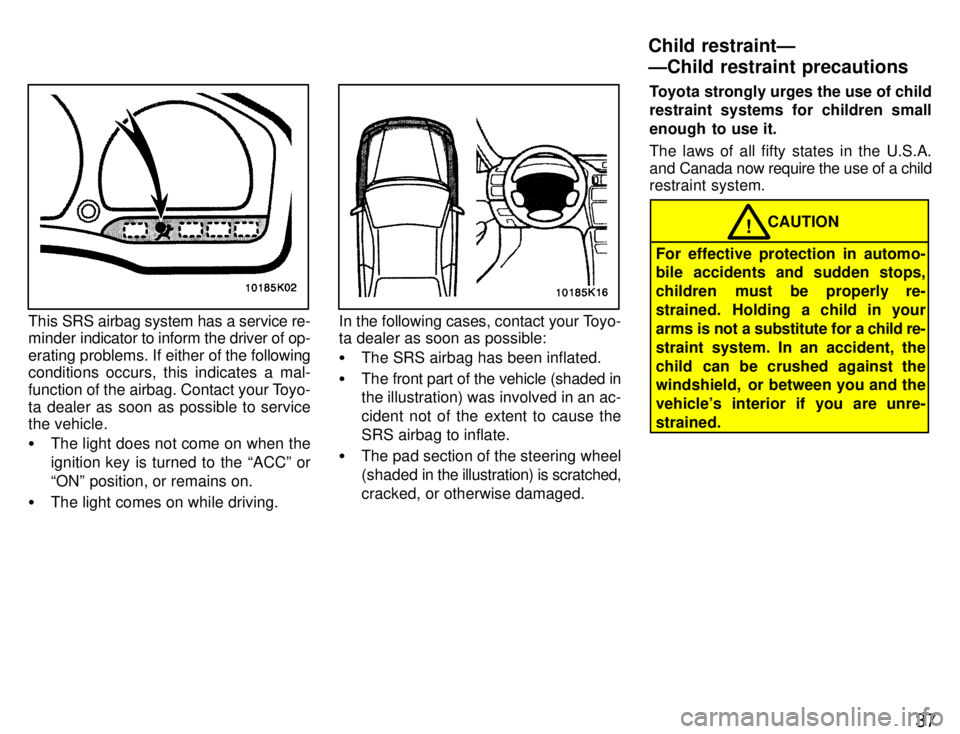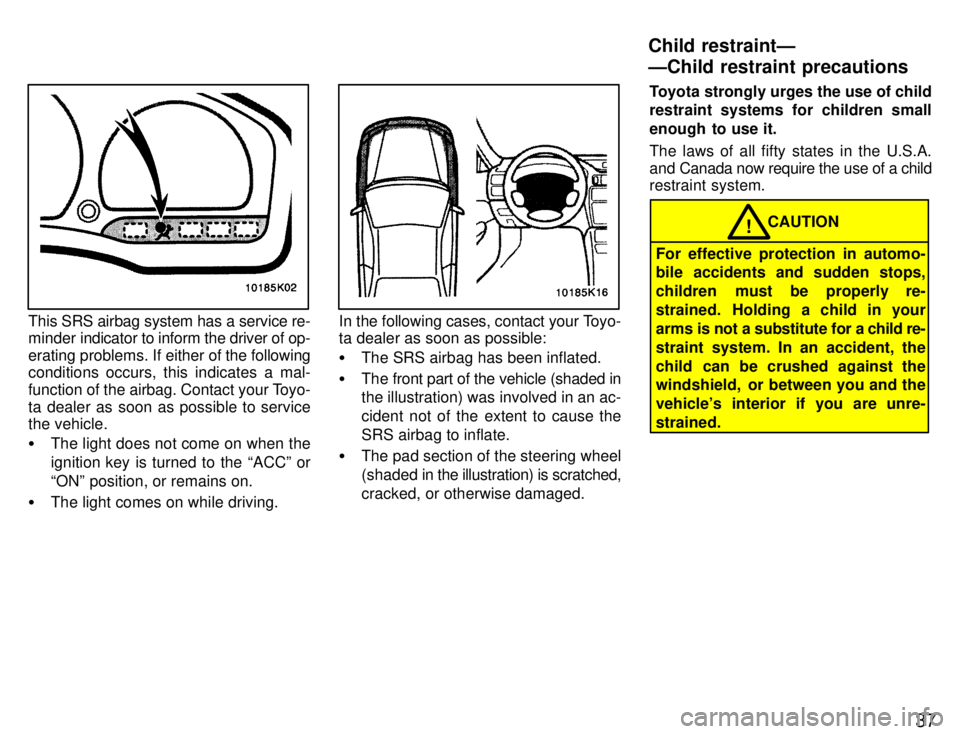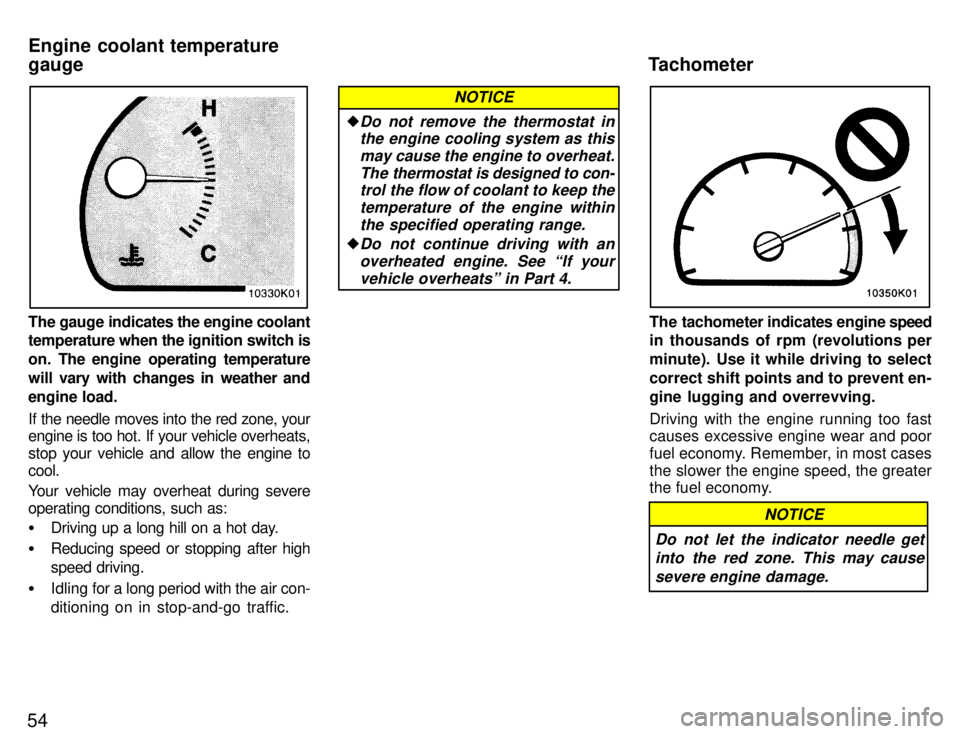air condition TOYOTA PASEO 1996 Owners Manual
[x] Cancel search | Manufacturer: TOYOTA, Model Year: 1996, Model line: PASEO, Model: TOYOTA PASEO 1996Pages: 165, PDF Size: 2.57 MB
Page 4 of 165

3
1. Instrument panel light control knob
2. Headlight and turn signal switch
3. Wiper and washer switches
4. Emergency flasher switch
5. Clock
6. Air conditioning controls
7. Car audio
8. Cigarette lighter
9. Ashtray
10. Cup holder
11. Rear window defogger switch
12. Ignition switch
13. Cruise control switch
Page 35 of 165

33
This SRS airbag system has a service re-
minder indicator to inform the driver of op-
erating problems. If either of the following
conditions occurs, this indicates a mal-
function of the airbags. Contact your To-
yota dealer as soon as possible to service
the vehicle. � The light does not come on when the
ignition key is turned to the ACCº or
ONº position, or remains on.
� The light comes on while driving.In the following cases, contact your Toyo-
ta dealer as soon as possible: �The SRS airbags have been inflated.
� The front part of the vehicle (shaded in the illustration) was involved in an ac-
cident not of the extent to cause the
SRS airbags to inflate.
� The pad section of the steering wheel
or front passenger airbag cover
(shaded in the illustration) is scratched,
cracked, or otherwise damaged.The SRS (Supplemental Restraint Sys-
tem) airbag is designed to provide fur-
ther protection to the driver when add-
ed to the primary protection providedby the seat belt.
In response to a severe frontal impact, the
SRS airbag works together with the seat belt to help prevent or reduce injury by in-
flating, in order to decrease the likelihood
of the driver's head or chest directly hitting the steering wheel.
SRS airbag (for Canada)
Page 39 of 165

37
This SRS airbag system has a service re-
minder indicator to inform the driver of op-
erating problems. If either of the following
conditions occurs, this indicates a mal-
function of the airbag. Contact your Toyo-
ta dealer as soon as possible to service the vehicle. � The light does not come on when the
ignition key is turned to the ACCº or
ONº position, or remains on.
� The light comes on while driving.In the following cases, contact your Toyo-
ta dealer as soon as possible: �The SRS airbag has been inflated.
� The front part of the vehicle (shaded in the illustration) was involved in an ac-
cident not of the extent to cause the
SRS airbag to inflate.
� The pad section of the steering wheel
(shaded in the illustration) is scratched,
cracked, or otherwise damaged. Toyota strongly urges the use of child
restraint systems for children small
enough to use it.
The laws of all fifty states in the U.S.A.
and Canada now require the use of a child
restraint system.
CAUTION!
For effective protection in automo-
bile accidents and sudden stops,
children must be properly re-
strained. Holding a child in your
arms is not a substitute for a child re-
straint system. In an accident, the
child can be crushed against the
windshield, or between you and the
vehicle's interior if you are unre-strained.
Child restraintÐ ÐChild restraint precautions
Page 40 of 165

37
This SRS airbag system has a service re-
minder indicator to inform the driver of op-
erating problems. If either of the following
conditions occurs, this indicates a mal-
function of the airbag. Contact your Toyo-
ta dealer as soon as possible to service the vehicle. � The light does not come on when the
ignition key is turned to the ACCº or
ONº position, or remains on.
� The light comes on while driving.In the following cases, contact your Toyo-
ta dealer as soon as possible: �The SRS airbag has been inflated.
� The front part of the vehicle (shaded in the illustration) was involved in an ac-
cident not of the extent to cause the
SRS airbag to inflate.
� The pad section of the steering wheel
(shaded in the illustration) is scratched,
cracked, or otherwise damaged. Toyota strongly urges the use of child
restraint systems for children small
enough to use it.
The laws of all fifty states in the U.S.A.
and Canada now require the use of a child
restraint system.
CAUTION!
For effective protection in automo-
bile accidents and sudden stops,
children must be properly re-
strained. Holding a child in your
arms is not a substitute for a child re-
straint system. In an accident, the
child can be crushed against the
windshield, or between you and the
vehicle's interior if you are unre-strained.
Child restraintÐ ÐChild restraint precautions
Page 57 of 165

54
The gauge indicates the engine coolant
temperature when the ignition switch is
on. The engine operating temperature
will vary with changes in weather and
engine load.
If the needle moves into the red zone, your
engine is too hot. If your vehicle overheats,
stop your vehicle and allow the engine to
cool.
Your vehicle may overheat during severe
operating conditions, such as: �Driving up a long hill on a hot day.
� Reducing speed or stopping after high
speed driving.
� Idling for a long period with the air con-
ditioning on in stop-and-go traffic.
NOTICE
�Do not remove the thermostat in the engine cooling system as this
may cause the engine to overheat.
The thermostat is designed to con-trol the flow of coolant to keep the
temperature of the engine within the specified operating range.
�Do not continue driving with anoverheated engine. See If your
vehicle overheatsº in Part 4.
The tachometer indicates engine speed
in thousands of rpm (revolutions per
minute). Use it while driving to select
correct shift points and to prevent en-
gine lugging and overrevving.
Driving with the engine running too fast
causes excessive engine wear and poor
fuel economy. Remember, in most cases
the slower the engine speed, the greater
the fuel economy.
NOTICE
Do not let the indicator needle get into the red zone. This may cause
severe engine damage.
Tachometer
Engine coolant temperature gauge
Page 59 of 165

56(a) Brake System Warning Light This light has the following functions: Parking brake reminder
If this light is on, make sure the parking
brake is
fully released. The light should go
off.
Low brake fluid level warning
If this light comes on and stays on while
you are driving, slow down and pull off the
road. Then stop the vehicle carefully.There may be a problem somewhere in
the brake system. Check the fluid level of
the see-through reservoir.
To make sure the parking brake has not
caused the warning light to come on,
check to see that the parking brake is fully
released.
If the brake fluid level is low...
At a safe place, test your brakes by start-
ing and stopping. � If you judge that the brakes still work
adequately, drive cautiously to yournearest dealer or shop for repairs.
� If the brakes are not working, have the
vehicle towed in for repairs. (For tow- ing information, see Part 4.)
It is dangerous to continue driving
normally when the brake fluid level
is low. CAUTION
!
If the brake fluid level is correct...
Have the warning system checked by
your Toyota dealer.
(b) Seat Belt Reminder Light and Buzzer
Once the ignition key is turned to ONº or
STARTº, the reminder light and buzzer
come on if the driver's seat belt is not fas- tened. Unless the driver fastens the belt, the light stays on and the buzzer soundsfor about 4 to 8 seconds.
(c) Discharge Warning Light
This light warns that the battery is being discharged.
If it comes on while you are driving, there
is a problem somewhere in the chargingsystem.
The engine ignition will continue to oper-
ate, however, until the battery is dis-
charged. Turn off the air conditioning,
blower, radio, e tc., and drive directly to the
nearest Toyota dealer or repair shop.NOTICE
Do not continue driving if the engine drive belt is broken or loose.
(d) Low Oil Pressure Warning Light
This light warns that the engine oil pres-
sure is too low.
If it flickers or stays on while you are driv-
ing, pull off the road to a safe place and
stop the engine immediately. Call a Toyota
dealer or qualified repair shop for assis- tance.
The light may occasionally flicker when
the engine is idling or it may come on brief-
ly after a hard stop. There is no cause for concern if it then goes out when the en-
gine is accelerated slightly.
The light may come on when the oil level
is extremely low. It is not designed to indi-cate low oil level, and the oil level must be checked using the level dipstick.
NOTICE
Do not drive the vehicle with the warning light onÐeven for one
block. It may ruin the engine.
Page 60 of 165

57
(a) Malfunction Indicator Lamp
This lamp comes on in the following cases.
a. The fuel tank is completely empty.
(See Fuel gaugeº in Chapter 1-5 for in- structions.)
b. There is a
problem somewhere in your
engine or automatic transmission electri- cal system.
If it comes on while you are driving in case
b, have your vehicle checked/repaired by
your Toyota dealer as soon as possible.
(b) Low Fuel Level Warning Light
This light comes on when the fuel level in
the tank becomes nearly empty. Fill up the
tank as soon as possible.
(c) ABSº Warning Light
This light warns that there is a problem
somewhere in your anti-lock brake sys- tem.
If the light comes on while you are driving,
have your vehicle checked by your T oyota
dealer as soon as possible.
The light comes on when the ignition key
is turned to the ONº position. After about
3 seconds, the light will go off. When the ABSº warning light is on (and
the brake system warning light is off), the brake system
operates conventionally but
without anti-lock function.
(d) Open Door Warning Light
This light remains on until both side doors
are completely closed.
(e) SRS Airbag Warning Light
This light will come on when the igni-
tion key is turned to the ACCº or ONº
position. After about 6 seconds, the
light will go off. This means the airbag
system is operating properly.
The warning light system monitors the air
bag sensor assembly, inflators, warning
light, interconnecting wiring and power sources.
If either of the following conditions occurs, this indicates a malfunction somewhere in the parts monitored by the warning light
system. Contact your Toyota dealer as
soon as possible to service the vehicle. � The light does not come on when the
ignition key is turned to the ACCº or
ONº position or remains on.
� The light comes on while driving. (f) Light Reminder Buzzer
The buzzer will sound if the driver's door is opened with the key removed from the
ignition switch and the headlight switch
left on.
(g) Key Reminder Buzzer
This buzzer reminds you to remove the
key when you open the driver's door with the ignition key in the ACCº or LOCKºposition.
CHECKING SERVICE REMINDER
INDICATORS
1. Apply the parking brake.
2. Open either side door.
The open door warning light should come on.
3. Close the door.
The open door warning light should go off.
4. Turn the ignition key to ACCº.
The SRS airbag warning light should
come on. It goes off after about 6 sec- onds.
Page 70 of 165

Part 1Car audio systemÐ ÐReference ÐUsing your audio system:
some basics
67
OPERATION OF INSTRUMENTS AND CONTROLSÐ
Chapter 1-7 Car audio system and Air conditioningsystem
Car audio system �
Reference
�Using your audio system: some basics
�Using your audio system: controls and features
�Car audio system operating hints
Air conditioning system �
Controls
�Air flow selector settings
�Operating tips
�Side vents
Type 1: AM´FM ETR radio
Type 2: AM´FM ETR radio/cassette player
This section describes some of the basic
features on Toyota audio systems. Some
information may not pertain to your sys-tem.
Your audio system works when the igni- tion key is in the ACCº or ONº position. TURNING THE SYSTEM ON AND OFF Push PWR
VVOLº or PWR/VOLº to turn
the audio system on and off. Push AM VFMº or TAPEº to turn on that
function without pushing PWR VVOLº or
PWR/VOLº.
You can turn on the cassette player by in- serting a cassette tape.
You can turn off the cassette player by
ejecting the cassette tape. If the audio
system was previously off, then the entire
audio system will be turned off when you eject the cassette tape. If the radio was
previously on, it will come on again. SWITCHING BETWEEN FUNCTIONS Push AM VFMº or TAPEº if the system is
already on but you want to switch from
one function to the another.
Page 80 of 165

77
1. Air Intake Selector
2. Air Flow Selector
3. Temperature Selector
4. Fan Speed Selector
5. A/Cº Button (on some models)
Air conditioning systemÐ ÐControls
Page 82 of 165

79
Air intake selector Move the lever to select the air source.
1. RecirculateÐRecirculates the air in-
side the vehicle.
2. Fresh ÐDraws outside air into the sys-
tem. A/Cº button
To turn on the air conditioning, press the
A/Cº button. The A/Cº button indicator
will come on. To turn the air conditioning
off, press the button again.
If the A/Cº button indicator flashes, there
is a problem in the air conditioning system
and the air conditioning automatically
shuts off. If this happens, take your ve-
hicle to a Toyota dealer for service.